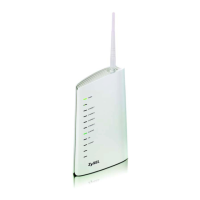Chapter 5 WAN Setup
P-870HW-51a v2 User’s Guide
64
Figure 32 Full Cone NAT Example
Symmetric NAT
The full, restricted and port restricted cone NAT types use the same mapping for an outgoing
packet’s source address regardless of the destination IP address and port. In symmetric NAT,
the mapping of an outgoing packet’s source address to a source address in another network is
different for each different destination IP address and port.
In the following example, the ZyXEL Device maps the source address IP address 1 and port A
to IP address 2 and port B on the external network for packets sent to IP address 3 and port C.
The ZyXEL Device uses a different mapping (IP address 2 and port M) for packets sent to IP
address 4 and port D.
A host on the external network (IP address 3 and port C for example) can only send packets to
the internal host via the external IP address and port that the NAT router used in sending a
packet to the external host’s IP address and port. So in the example, only 3, C is allowed to
send packets to 2, B and only 4, D is allowed to send packets to 2, M.
Figure 33 Symmetric NAT
Introduction to VLANs
A Virtual Local Area Network (VLAN) allows a physical network to be partitioned into
multiple logical networks. Devices on a logical network belong to one group. A device can
belong to more than one group. With VLAN, a device cannot directly talk to or hear from
devices that are not in the same group(s); the traffic must first go through a router.
2, B
1, A
1, A
2, M
2, B
4, D
4, E
3, C
5, B

